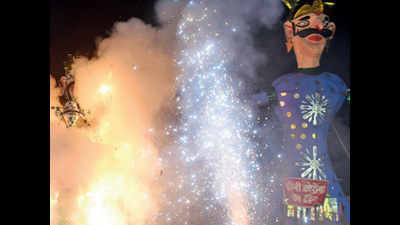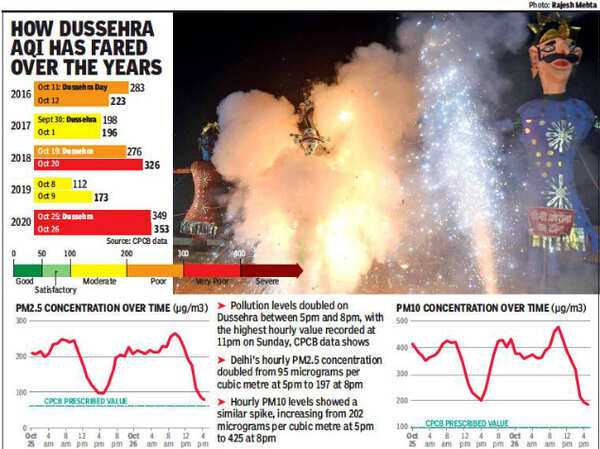- News
- City News
- delhi News
- Delhi: Late Dussehra, wind woes keep AQI up despite Covid controls
Trending
This story is from October 27, 2020
Delhi: Late Dussehra, wind woes keep AQI up despite Covid controls
Despite restrictions imposed on gatherings due to Covid-19, the use of firecrackers during Dussehra celebrations and the traditional effigies being burnt across the city sent pollution spiralling after 7pm on Sunday.

Pollution levels doubled on Dussehra between 5pm and 8pm, with the highest hourly value recorded at 11pm on Sunday, CPCB data shows
NEW DELHI: Despite restrictions imposed on gatherings due to Covid-19, the use of firecrackers during Dussehra celebrations and the traditional effigies being burnt across the city sent pollution spiralling after 7pm on Sunday.
Track the pollution level in your city
The hourly PM2.5 data at 5pm read 95 micrograms per cubic metre but doubled to 196 micrograms per cubic metre within three hours. The pollution peaked at 11pm with an hourly reading of 226 micrograms per cubic metre before a drop.While Sunday logged an AQI reading of 349 (very poor), it was 353 (very poor) on Monday’s daily, showing overall there was barely a change in pollution levels the day following Dussehra, which otherwise usually sees an increase in the AQI of 30-40 points.

While this is statistically the worst Dussehra in terms of AQI, experts contented that the date of the festival and the prevailing meteorological conditions determined the spike in pollutants. Sumit Sharma, director (Earth Science and Climate Change), TERI, said, “This year, Dussehra was celebrated in adverse meteorological conditions. It appears that fewer effigies were burnt than last year, but there was more accumulation of pollutants due to low wind speed and shallow mixing height.”
Last year, Dussehra fell in early October and had recorded an AQI of 112 (moderate). The following day, October 9, the AQI went up to 173. In 2018, Dussehra was celebrated closer to this year’s date, October 19, and the AQI spiked by around 50 points to 326 (very poor) the following day. In 2017 and 2016, a slight improvement was recorded the day after the festival, apparently due to a change for the better in wind speed.
Anumita Roy Chowdhury, executive director (research and advocacy), Centre for Science and Environment, added, “As Dussehra arrived by the end of October this time, we lost the weather advantage that prevented trapping of pollutants. Even Diwali was celebrated in 2018 at around this time and we saw a big spike in air quality.”
The System of Air Quality and Weather Forecasting and Research (SAFAR), a forecasting body under the Union ministry of earth sciences, reported an increase in wind speed on Monday. “The SAFAR model suggests a marginal improvement in the current condition on Tuesday, though AQI is predicted to remain in the ‘very poor’ range for the next two days,” read its outlook on Monday. “SAFAR’s synergised stubble fire counts increased to 1,275 on Sunday and the SAFAR model estimates the share of stubble burning in PM2.5 to be 16% on Monday. In summary, while the expected slight increase in local surface wind speed is a positive sign for Tuesday, these improved winds speed are not likely to stay for long.”
Track the pollution level in your city
The hourly PM2.5 data at 5pm read 95 micrograms per cubic metre but doubled to 196 micrograms per cubic metre within three hours. The pollution peaked at 11pm with an hourly reading of 226 micrograms per cubic metre before a drop.While Sunday logged an AQI reading of 349 (very poor), it was 353 (very poor) on Monday’s daily, showing overall there was barely a change in pollution levels the day following Dussehra, which otherwise usually sees an increase in the AQI of 30-40 points.

CPCB data showed a similar spike in the hourly PM10 readings, which doubled between 5pm and 8pm. While the hourly PM10 reading at 5pm was 202 micrograms per cubic metre, it had risen to 425 micrograms per cubic metre by 8pm. The standard acceptable limit for PM10 is 100 micrograms per cubic metre.
While this is statistically the worst Dussehra in terms of AQI, experts contented that the date of the festival and the prevailing meteorological conditions determined the spike in pollutants. Sumit Sharma, director (Earth Science and Climate Change), TERI, said, “This year, Dussehra was celebrated in adverse meteorological conditions. It appears that fewer effigies were burnt than last year, but there was more accumulation of pollutants due to low wind speed and shallow mixing height.”
Last year, Dussehra fell in early October and had recorded an AQI of 112 (moderate). The following day, October 9, the AQI went up to 173. In 2018, Dussehra was celebrated closer to this year’s date, October 19, and the AQI spiked by around 50 points to 326 (very poor) the following day. In 2017 and 2016, a slight improvement was recorded the day after the festival, apparently due to a change for the better in wind speed.
Anumita Roy Chowdhury, executive director (research and advocacy), Centre for Science and Environment, added, “As Dussehra arrived by the end of October this time, we lost the weather advantage that prevented trapping of pollutants. Even Diwali was celebrated in 2018 at around this time and we saw a big spike in air quality.”
The System of Air Quality and Weather Forecasting and Research (SAFAR), a forecasting body under the Union ministry of earth sciences, reported an increase in wind speed on Monday. “The SAFAR model suggests a marginal improvement in the current condition on Tuesday, though AQI is predicted to remain in the ‘very poor’ range for the next two days,” read its outlook on Monday. “SAFAR’s synergised stubble fire counts increased to 1,275 on Sunday and the SAFAR model estimates the share of stubble burning in PM2.5 to be 16% on Monday. In summary, while the expected slight increase in local surface wind speed is a positive sign for Tuesday, these improved winds speed are not likely to stay for long.”
End of Article
FOLLOW US ON SOCIAL MEDIA










